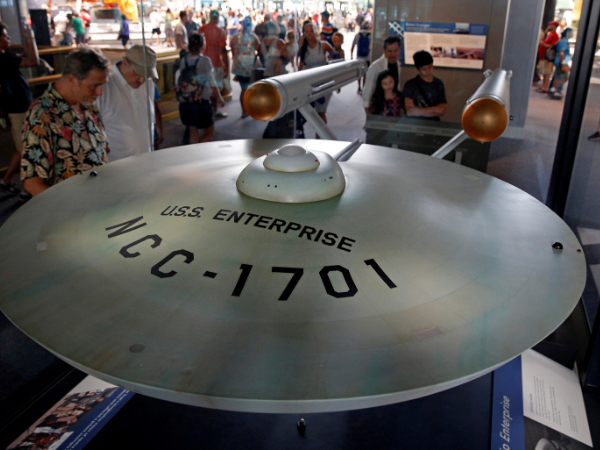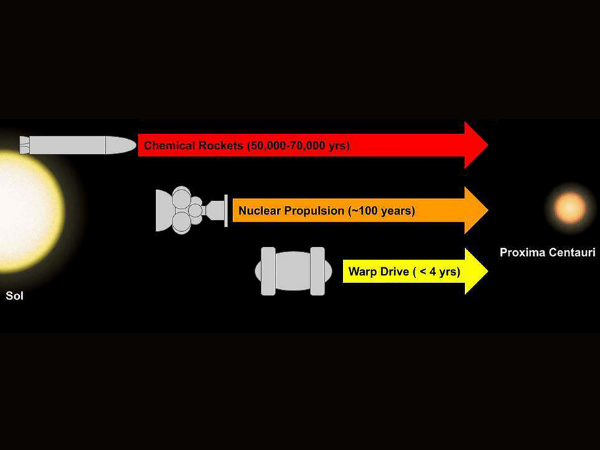Is light-speed travel possible like in Star Wars and Star Trek?
Spaceships zipping at the speed of light or faster are a staple of science fiction. Think of the Millennium Falcon in the “Star Wars” movies and the starship Enterprise in “Star Trek.” Such travel sounds like fanciful speculation. But is it?
A new research paper authored by an American physicist offers a potential blueprint for superluminal travel – faster than the speed of light – using conventional physics rather than a construct based upon hypothetical particles and states of matter with exotic physical properties.

Visitors to the Smithsonian Air and Space Museum see the fully restored original USS Enterprise model from the 1960s “Star Trek” TV series in Washington July 7, 2016. REUTERS/Kevin Lamarque/File Photo
The paper, published this week in the journal Classical and Quantum Gravity, moves the question of superluminal travel a step away from theoretical research and a step toward an engineering challenge, according to physicist Erik Lentz, who did the work while at the University of Göttingen in Germany.
A huge hurdle remains, Lentz said, in finding a way to vastly reduce the immense amount of energy needed to power a theoretical ‘warp drive’ engine before any hope of building a prototype.
“A ‘warp drive’ technology is principally envisioned to speed up transportation in deep space,” Lentz said. “It can be used to enhance current ambitions for interplanetary and interstellar travel by drastically shortening travel times and widening mission windows.”
The nearest star beyond our solar system is Proxima Centauri, located 4.25 light years – the distance it takes light to travel in a year – away. Light travels at about 186,000 miles per second (300,000 km per second) and 5.9 trillion miles (9.5 trillion km) in a year.

An undated artistic impression shows different spacecraft designs considering theoretical shapes of different kinds of “warp bubbles” to achieve speeds exceeding the speed of light. Erik Lentz/Handout via REUTERS.
Using traditional rocket fuel, it would take about 50,000 to 70,000 years to reach Proxima Centauri, and nuclear propulsion with proposed technology would get there in about 100 years, Lentz said. A light speed trip would take four years and three months.
Lentz’s blueprint envisions above-light-speed travel, which “holds the potential for one-way and round-trip distant interstellar travel within a human lifetime.”
“If we are limited to traveling at sub-light speed, then multi-generational spaceships must be used for destinations beyond the nearest stars, which is basically a glorified burial casket for at least the first generation of people. I do not find that prospect nearly as inspiring,” Lentz said.
His paper describes the theoretical construction of a class of soliton – a compact self-sustaining wave moving with constant velocity through space – capable of superluminal motion. These solitons are often referred to as “warp bubbles” and they would provide the basis for a propulsion system.
“Currently, the amount of energy required for this new type of space propulsion drive is still immense,” Lentz said. For a spacecraft of about 650 feet (200 meters) in diameter to exceed light speed, that could mean perhaps the energy equivalent of hundreds of times the mass of Jupiter, our solar system’s largest planet – a preposterous amount.
A lot of work would be needed to bring this to fruition. Making it practical, Lentz said, would require lowering the energy needs drastically down to the range of modern nuclear fission reactors. A way to create and accelerate the solitons also must be devised, Lentz added.
Lentz views the task as difficult, but not impossible. He said the next phase of theoretical research and development work could unfold over the next several years, with a fully functional prototype drive possible within the coming decade.
“The first truly superluminal drives may come some decades thereafter,” Lentz said. “I would like to see this technology in use in my lifetime.”
(Reporting by Will Dunham, Editing by Rosalba O’Brien)

